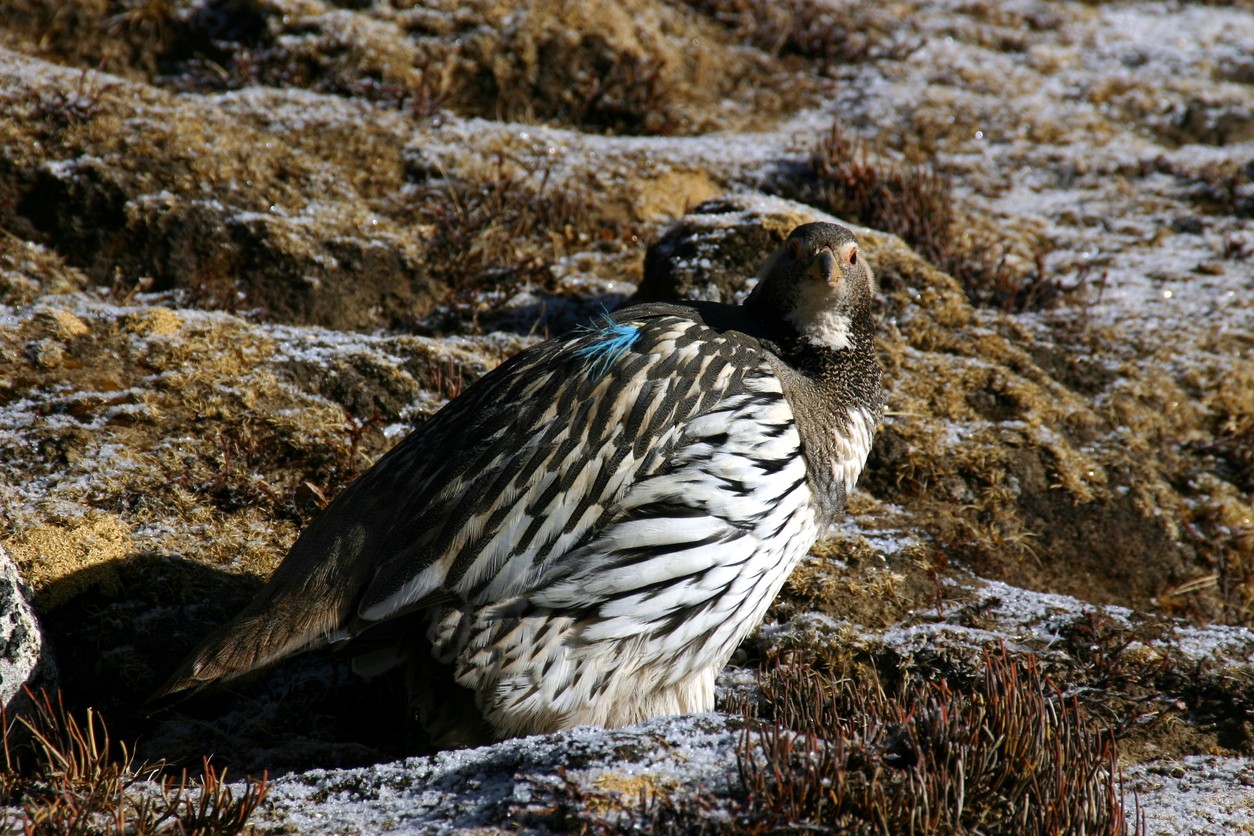Himalayan Snowcock
A species of Snowcocks Scientific name : Tetraogallus himalayensis Genus : Snowcocks
Himalayan Snowcock, A species of Snowcocks
Botanical name: Tetraogallus himalayensis
Genus: Snowcocks
Content
Description General Info

Description
The Himalayan snowcock is a large grey partridge-like bird, 55–74 cm (22–29 in) in length and weighing 2–3.1 kg (4.4–6.8 lb). The head pattern has a resemblance to that of the smaller and well marked chukar partridge. The white throat and sides of the head are bordered by chestnut moustachial stripe and a dark broad chestnut band stretching from the eye over the ear, expanding into the collar. The upper parts are grey, with feathers of the rump and the wings are bordered with rufous. The upper breast is grey with dark crescent bars. The lower breast plumage is dark grey, and the sides of the body are streaked with black, chestnut and white. The undertail coverts are white. The legs and orbital skin are yellow. Sexes are alike in plumage, but the female is smaller and lacks the large tarsal spur of the male. In flight, from above, the white primaries tipped in black and the rufous outer tail feathers make it distinctive. The Tibetan snowcock has a wing pattern with white trailing edge to the secondaries that contrasts with the grey wings. 
Size
41 - 81 cm
Nest Placement
Ground
Feeding Habits
Himalayan Snowcock mainly consumes grasses, forbs, and seeds, supplemented with berries, bulbous roots, and tubers. They forage by walking, and their unique diet often includes insects, indicating an omnivorous preference.
Habitat
Himalayan Snowcock inhabit open mountain slopes, preferring elevations ranging from just below the tree-line to the snowline, typically found between 2500 meters and 6000 meters. These birds thrive in steep alpine pastures and along rocky ridges, where they can navigate the challenging terrain. Their favored environments are characterized by expansive open spaces offering a blend of rugged terrain and sparse vegetation.
Dite type
Herbivorous
General Info
Feeding Habits
Bird food type
Behavior
Himalayan snowcocks are gregarious when not breeding, moving around in small groups. Several groups may inhabit the same hill. They keep entirely to open country and seem to prefer rocky hill-sides. They feed on grass, shoots, berries and seeds. In the mornings the birds fly downhill to drink water. When approached from below their level, they attempt to climb up the slopes on foot and when approached from above they dive down the valleys on open wings. In India, the breeding season is in summer, April to June. It is silent in winter but in spring, its call is a familiar part of the landscape. The song is a loud whistle with three parts with the tone ascending. They also make a rising, shrill piping call. When feeding they walk slowly up hill, picking up the tender blades of grass and young shoots of plants on the way. They have been noted feeding on the berries of Ephedra, leaves of Artemisia, grass shoots, bulbs and the heads of a rye-like grass. In the Hunza range, they have been observed to prefer Sibbaldia cuneata. Once they reach the top of a ridge of the hill, they fly off to adjacent hill, alighting some distance down, and again picking their way upwards. When walking, they cock their tails showing the white under tail coverts. They are generally wary and when disturbed run uphill and then launch themselves from the crests in flight, getting up considerable speed. They are more prone to predation on the alpine pastures than on steep slopes and flocking helps them to keep more eyes out for predators allowing them to forage more efficiently. In the Hunza range, flock sizes tended to be larger in rocky habitats, where they risked being attacked by Golden Eagles, than on grassy meadows. The breeding season is summer, April to June. During courtship, the male crouches low down to the ground with wings slightly spread, tail depressed and feathers slightly ruffled. Then, he runs backwards and forwards in front of the hen or in circles. The nest is a bare ground scrape sheltered under a stone or bush, preferably close to the crest of a ridge on the leeward side. About 5 to 12 long oval eggs are laid which are a stony olive or brown colour and spotted throughout with red or brown. The eggs are incubated only by the female. The male is monogamous, staying in the vicinity of the nest often seen perched on some elevated rock and keeping a watch against intruders. When disturbed, the cock warns the female with a loud whistle. If caught unaware in the nest, the hen bird will not leave the nest until approached very close. The eggs hatched in an incubator after about 27–28 days. Adults are sometimes preyed on by golden eagles. Several species of endoparasitic Acanthocephala and Nematoda such as Hispaniolepis fedtschenkoi, have been described from the species. 
Distribution Area
Himalayan snowcock frequents alpine pastures and steep ridges of mountains of Central and South Asia above the treeline and near the snowline. In the Himalayas, it is found between 4000 and 5000 m elevation in summer, descending to 2400 m during severe winters. Since the Himalayan snowcock has a large distribution range and no visible declines in population, it has been considered a species of "least concern" by the IUCN. In 1961 the similarity of the Himalayan landscape to the Nevada region was noted and the Himalayan snowcock was considered as a good game bird for introduction by the Nevada Fish and Game Commission. The Commission then approached the President of Pakistan for some birds. These were wild trapped in Hunza and early shipments faced heavy losses after which birds were locally reared at Mason Valley game farm and over a 15-year period (1965–1979) more than 2000 birds were released into the wild. A wild population more than 200 to 500 birds has established itself in the Ruby Mountains, where they forage above the treeline. 

